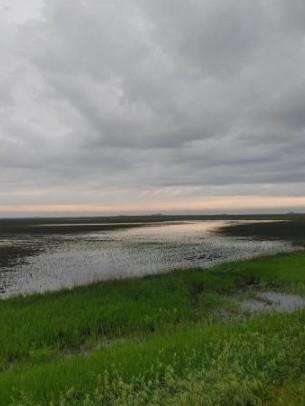Flooding

Flooding in a Central Iowa corn field.
With the recent flash flooding and subsequent ponding in parts of central, west central, and southern Iowa, many farmers are wondering how long their crops will survive under water and what to do next if the crops don’t survive. With the high temperatures we’ve received since the rain, most emerged crops will only survive a few days in those saturated conditions. As flood waters recede, farmers will need to evaluate how much of the crop survived and the need for replant or filling in thin stands.
We’ve got some helpful resources that I’ve linked below for those farmers needing information on crop survival, replant/filling in crops, and other flood disaster resources.
Hail
Some parts of southern Iowa received significant hail earlier this week, resulting in crop damage to corn and soybean. Most corn in the affected area is between the V2 and V6 growth stage, while soybeans are primarily in the VE to V2 growth stage. While prioritizing an immediate call to your crop insurance agent is important, farmers will want to wait at least 5-7 days to evaluate regrowth on hail-damaged crops.
In corn fields that are V5 or smaller, regrowth over the next week should be visible and there should be negligible yield loss. If corn is V6 or larger, careful assessment of damage will be necessary to determine if the growing point is still viable and plants will recover.
Severe hail on very small soybeans may result in shearing of plant stems and loss of leaves this time of year. If plant stems are cut below the cotyledons, they will not regrow. Stand loss is the primary concern for yield loss this time of year, but populations generally quite low, perhaps less than 60-70,000 plants per acre, to be replanted. Plants with leaf loss or stem breakage above the cotyledons have a good chance of regrowing due to the presence of axillary buds at each leaf axil on the stem. Soybean plants can endure some leaf loss this time of year with minimal effect on yield, but fields may need to be monitored for weeds emerging later into the growing season.
Source : iastate.edu